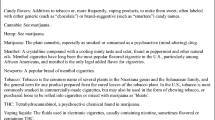Abstract
Tobacco control policies reduce the health and economic burden caused by tobacco. With over half of the United States communities lacking adequate protective policies, an examination of policy adoption factors can provide insights to facilitate policy adoption. A case study approach examines the rate of adoption, prominent media frames, policy leaders’ perceptions and coalition activities for smokefree and Tobacco 21 policies adopted in Missouri. Findings show compared to smokefree policy, Tobacco 21 requires a considerably shorter timeframe and fewer resources for adoption. Tobacco 21 coalitions target a small group of stakeholders compared to smokefree coalitions’ emphasis on broad community engagement. Both policies are formally opposed, but elected officials perceive less political risk supporting Tobacco 21. As a new tobacco control policy tool, Tobacco 21 has relative advantage that should be considered by community health advocates.


Similar content being viewed by others
References
Centers for Disease Control and Prevention. Best practices for comprehensive tobacco control programs-2014. (2014). Retrieved Jan 25, 2018 from https://www.cdc.gov/tobacco/stateandcommunity/best_practices/pdfs/2014/comprehensive.pdf.
Tobacco Control Network 2016 policy recommendations guide. (2016). Retrieved Jan 25, 2018 from http://tobaccocontrolnetwork.org/wp-content/uploads/2016/07/TCN-2016-Policy-Recommendations-Guide.pdf.
Levy, D. T., Tam, J., Kuo, C., Fong, G. T., & Chaloupka, F. (2018). The impact of implementing tobacco control policies: The 2017 tobacco control policy scorecard. Journal of Public Health Management & Practice. https://doi.org/10.1097/PHH.0000000000000780
Smoke-free policies: an action guide. (2009). Retrieved Feb 1, 2018 from http://www.prevent.org/data/files/initiatives/smokefreepolicies.pdf.
Best practices user guide: coalitions-state and community interventions. (2009). Retrieved Jan 31, 2018 from https://ftp.cdc.gov/pub/fda/fda/user_guide.pdf.
Studlar, D. T., & Cairney, P. (2014). Conceptualizing punctuated and non-punctuated policy change: tobacco control in comparative perspective. International Review of Administrative Sciences. 80(3), 513–531. https://doi.org/10.1177/0020852313517997.
ANRF. (2018). Summary of 100% smokefree state laws and population protected by 100% U.S. smokefree laws. Retrieved Jan 25, 2018 from http://www.no-smoke.org/pdf/SummaryUSPopList.pdf.
State of tobacco control 2018: state rankings. (2018). Retrieved Feb 1, 2018 from http://www.lung.org/our-initiatives/tobacco/reports-resources/sotc/state-grades/state-rankings/.
Broken promises to our children: a state-by-state look at the 1998 Tobacco Settlement 19 years later. Appendix A: History of state spending on tobacco prevention programs. 2017. Retrieved Jan 25, 2018 from https://www.tobaccofreekids.org/assets/content/what_we_do/state_local_issues/settlement/FY2018/Appendix%20A.pdf.
Cowan, S. R. (2013) Missouri communities indoor air quality in public places. Retrieved Feb 1, 2018 from http://www.tobaccofreemo.org/wp-content/uploads/2013/01/AirQualityReportNewCover.pdf.
Herman, P. M., & Walsh, M. E. (2011). Hospital admissions for acute myocardial infarction, angina, stroke, and asthma after implementation of Arizona’s comprehensive statewide smoking ban. American Journal of Public Health, 101(3), 491–496. https://doi.org/10.2105/AJPH.2009.179572.
Levy, D. T., Chaloupka, F., & Gitchell, J. (2004). The effects of tobacco control policies on smoking rates: a tobacco control scorecard. Journal of Public Health Management & Practice, 10(4):338–353.
Song, A. V., Dutra, L. M., Neilands, T. B., & Glantz, S. A. (2015 Sep). Association of smoke-free laws with lower percentages of new and current smokers among adolescents and young adults: an 11-year longitudinal study. JAMA Pediatrics, 169(9), e152285. https://doi.org/10.1001/jamapediatrics.2015.2285.
Farrelly, M. C., Loomis, B. R., Kuiper, N., Han, B., Gfroerer, J., Caraballo, R. S., et al. (2013). Are tobacco control policies effective in reducing young adult smoking? Journal of Adolescent Health, 54(4), 481–486. https://doi.org/10.1016/j.jadohealth.09.015.
Municipalities with local 100% smokefree laws currently in effect as of October 1, 2016. Retrieved Oct 19, 2016 from http://www.no-smoke.org/pdf/100ordlisttabs.pdf.
IOM (Institute of Medicine). (2015). Public health implications of raising the minimum age of legal access to tobacco products. Retrieved Jan 25, 2018 from http://nationalacademies.org/HMD/Reports/2015/TobaccoMinimumAgeReport.aspx.
Schneider, S. K., Buka, S. L., Dash, K., Winickoff, J. P., & Donnell, L. O. (2016). Community reductions in youth smoking after raising the minimum tobacco sales age to 21. Tobacco Control, 25(3), 355–359. https://doi.org/10.1136/tobaccocontrol-2014-052207.
Tobacco nation: the deadly state of smoking disparity in the U.S. 2017. Retrieved Feb 25, 2018 from https://truthinitiative.org/sites/default/files/Tobacco-Nation-FINAL.pdf.
Eckler, P., Rodgers, S., & Everett, K. (2016). Characteristics of community newspaper coverage of tobacco control and its relationship to the passage of tobacco ordinances. Journal of Community Health, 41(5), 953–961. https://doi.org/10.1007/s10900-016-0176-8.
Schneider, A., & Ingram, H. (1993). Social construction of target populations: Implications for politics and policy. American Political Science Review, 87(2), 334–347.
Satterlund, T. D., Cassady, D., Treiber, J., & Lemp, C. (2011 Sep). Strategies implemented by 20 local tobacco control agencies to promote smoke-free recreation areas, California, 2004–2007. Preventing Chronic Disease, 8(5), A111.
What to expect from the tobacco industry. (2006). Retrieved Jan 31, 2018 from http://no-smoke.org/pdf/whattoexpect.pdf.
Rogers, E. M. (2002). Diffusion of preventive innovations. Addictive Behaviors, 27(6), 989–993.
Acknowledgements
Thank you to research interns Tiffani Hunter and Casey Muckler for coding media data, analyst Jamie Smith for analyzing media data, and to the elected officials, government staff and coalition leaders who shared their time and stories to better understand the diffusion process of tobacco policy.
Author information
Authors and Affiliations
Corresponding author
Ethics declarations
Conflict of interest
The authors have no reportable conflicts of interests.
Rights and permissions
About this article
Cite this article
Everett, K.D., Chadwick, G., Cowan, S.R. et al. Tobacco Control Policy Adoption Dynamics: A Case Study of Missouri Communities. J Community Health 43, 802–809 (2018). https://doi.org/10.1007/s10900-018-0487-z
Published:
Issue Date:
DOI: https://doi.org/10.1007/s10900-018-0487-z




